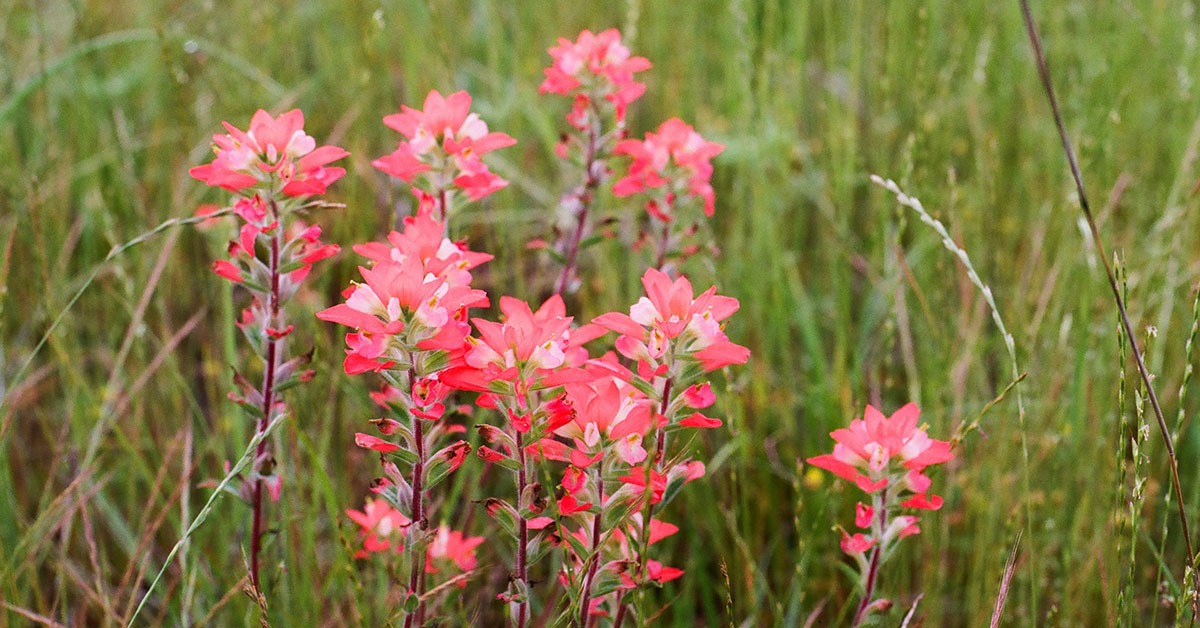If you find yourself walking through a meadow anywhere from Northwest Russia all the way down to the Andes Mountains in South America and you saw a beautiful pink brush-like flower sticking up out of the grass, there’s a good chance you’ve spied Indian Paintbrush, a perennial flower with an extensive native range.
Indian Paintbrush isn’t just a wildflower growing in meadows, it can be planted on your property too. It can be a little bit tricky to get it started though, which makes it a less common garden flower. In this article, we’ll take a deep dive into growing this beautiful, brush-like flower on your property.
Growing Indian Paintbrush
Before we get planting, let’s take an in-depth look at the facts about this lovely meadow flower.
- Latin name: Castilleja
- Other names: Prairie fire
- Native to: Large range from Northwest Russia to the Andes Mountains.
- Invasiveness: Not invasive
- Tenderness: Biennial
- Sun: Full sun
- Water: Occasional
- Soil: Well drained
- Hardiness zone: 6-11
- When to plant: From seed, early spring to late summer
- Spacing: 6 inches
- Plant height: Up to 16 inches
- Bloom period: All year
- Time to maturity: 2 years
- Container friendly: Somewhat
- Fertilizer: Do not fertilize
- Toxicity: Yes, leaves and roots are toxic
- Drought resistant: Somewhat
- Deer resistant: Yes
- Pest resistant: Yes
Indian Paintbrush, sometimes known as Prairie fire for its red, firey flowers, has a lengthy native range from Russia to Western Canada and the United States all the way down to the Andes Mountains. There are, in total, 107 different varieties of Indian Paintbursh. It can grow up to 9,000 feet in elevation and prefers full sun. It’s a biennial, meaning it grows for 2 years and then dies. It is fully mature in its second year.
This flower appreciates rocky, well-drained soil, and occasional water, and is only grown in hardiness zones 6-11. It has a spread of 6 inches and should be spaced a minimum of 6 inches apart and can grow up to 16 inches. It blooms for much of the year, depending on the zone in which it is planted.
It tolerates containers but prefers to be planted in the ground. The leaves and roots are known to be toxic. It’s somewhat drought resistant but does well with occasional watering. It is known to be deer resistant and pest resistant.
Water
This meadow flower is a drought-resistant plant, but it does still enjoy being watered. The occasional weekly watering will suit it well. This flower does great in xeriscaped landscapes. Be careful not to excessively water this plant, especially once it’s established.
Sunlight
This flower grows in forest clearings, meadows, and fields. It is adapted to grow well in a full sunlight environment with little to no shade.
Soil
Special potting soil really isn’t necessary for this flower. In fact, it may be a detriment. Indian Paintbrush prefers sandy, rocky, well-drained soil.
Fertilizing
Indian Paintbrush does not need to be fertilized, and some gardeners actively discourage it. Don’t fertilize your Indian Paintbrush!
Invasiveness
Indian Paintbrush is not considered invasive outside of its native range, but it is well adapted to growing within its native range. If you are outside of this range, I don’t encourage you to plant this flower.
Growing Indian Paintbrush in containers
Indian Paintbrush can tolerate being planted in a container, but be careful to fill it with sandy, rocky, well-draining soil. If grown in a container, it may need a bit more water than if grown in the ground, as container plants can dry out quicker.
Common problems
Indian Paintbrush is a hardy plant that rarely experiences pest problems or disease. If you get it established, it’ll do fine.
Propagating Indian Paintbrush
Indian Paintbrush doesn’t like being transplanted – it’s one reason the flower isn’t especially common in flowerbeds. It does do fine when grown from seed. You can start these seeds directly in the ground any time from early spring to late summer. Bear in mind this plant is a biennial, so during its second year, you’ll want to collect seeds to grow the following year.
Wildlife attracted by Indian Paintbrush
Indian Paintbrush is known to attract native pollinators, like butterflies, flies, bees, and hummingbirds. It’s a wonderful plant to plant inside of its native range, as your local, non-invasive pollinators are adapted to it.
Uses for Indian Paintbrush
This flower is known to contain high quantities of selenium, a mineral found in the body. It is so high in selenium that overconsumption can cause selenium toxicity, leading to nausea and vomiting, nail discoloration, brittleness, hair loss, irritability, and bad breath. The Chippewa Indians used it to treat treat rheumatism and as a cosmetic hair conditioner.













